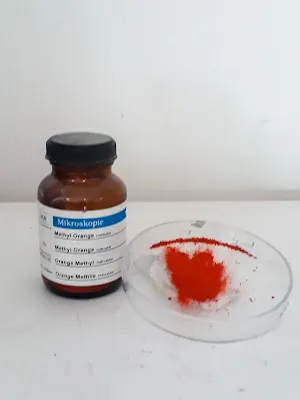General Information
- Read - Guidelines for Handling and Storage - Methyl Orange SDS!
- Product Name: Methyl Orange.
- Signal sign: Danger!
- Synonyms: C.I. Acid Orange 3, C.I. 14700, Methyl Orange B Base.
- CAS Number: 547-58-0.
- EINECS Number: 208-828-9.
- Component Name: Methyl Orange.
- Formula: C14H15N3O3SNa
- Formula Wt.: 327.334
- Synonyms: Sodium p-dimethylaminoazobenzenesulfonate; C.I. 13025
First-Aid Measures
Hazards Identification
- Hazard class: Acute toxicity, oral
- Skin Irritation: Not classified.
- Eye Irritation: Not classified.
- Sensitization: Not classified.
- Carcinogenicity: Not classified.
- Reproductive Toxicity: Not classified.
- Specific Target Organ Toxicity (Single Exposure): Not classified.
- Specific Target Organ Toxicity (Repeated Exposure): Not classified.
- Aspiration Hazard: Not classified.
- If swallowed: It is Toxic.
- Avoid eating, drinking, and smoking while taking this product.
Handling & Storage
- Store the container in a cool, dry area with the lid well closed.
- Store with stains, colors, & indicators.
- Stay away from the skin & eyes.
- Utilize sufficient ventilation.
- After handling, carefully wash your hands.
Exposure Controls/Personal Protection
- To avoid skin & eye contact, put on the proper protective gloves, clothes, and eye/face protection.
Accidental Release Measures
- Put on the proper personal protection gear.
- Avoid breathing in any mist or particles.
- Spills should be swept up or vacuumed up and put in an appropriate receptacle for disposal.
Fire-Fighting Measures
- Not deemed to be a fire threat.
- Not considered to be an explosive threat.
- Not considered to be a health risk.
- To put out fires, use water spray, foam, dry chemicals, or carbon dioxide.
Physical & Chemical Properties
- Appearance: orange powder.
- Odor: Burnt rubber-like odor.
- pH(indicator): 3.0 red through 4.4 yellow.
- Melting Point: Not available.
- Boiling Point: Not available.
- Flash Point: Not available.
- Evaporation Rate: Not available.
- Flammability: Not available.
- Upper/Lower Flammability or Explosive Limits: Not available.
- Vapor Pressure: Not available.
- Vapor Density: Not available.
- Solubility: Soluble in hot water & partially soluble in alcohol.
- Specific Gravity: Not available.
Stability & Reactivity
- Stable under typical circumstances.
- Strong acids & oxidizing agents are incompatible with each other.
Toxicological Information
- Acute effects: Harmful if swallowed.
- Chronic effects: N.A.
- Target organs: N.A.
- LD50 for ORL-RAT: 60 mg/kg
- LC50 for IHL-RAT: N.A.
- LD50 for SKN-RBT: N.A.
Ecological Information
- Not available.
Disposal Considerations
- Follow all local, state, and federal requirements when disposing of materials.
Transport Information
- Hazard class: 6.1, Keep away from food; shipping name: Toxic Solids, Organic, N.O.S.; UN number: UN2811
Regulatory Information
TSCA and EINECS listings (208-925-3).
Other Information

Methyl Orange is an indicator dye that adapts its hue to a solution's pH level. It is frequently employed in titrations and in laboratory research as a pH indicator.
Conclusion
Methyl Orange is an indicator dye that adapts its hue to a solution's pH level. It is not regarded as a dangerous material &, when handled appropriately, does not present a serious risk to one's health or safety. To avoid skin and eye contact, it's crucial to use the appropriate personal protective equipment & adhere to correct handling and storage techniques. The substance should be handled in a cold, dry environment & disposed of in compliance with all applicable federal, state, & local laws. Always follow Methyl Orange SDS!
